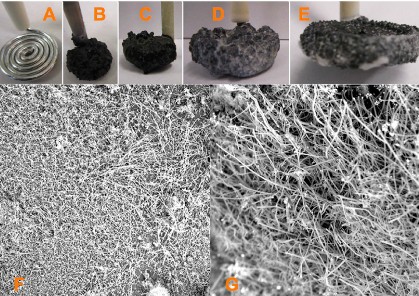August 21, 2015 – If we could directly harvest carbon dioxide (CO2) from the air and separate and capture the carbon while converting what’s left to oxygen then that would really be a technology breakthrough of consequence in our fight against global warming. Sounds like science fiction? Well it’s not.
Researchers at George Washington University have done just that. They are capturing CO2 and converting it to carbon nano-fibers and oxygen using a unique electro-chemical process. To achieve this feat they use solar power that makes use of the infrared spectrum to generate significant heat. The air is exposed to a solution of molten lithium carbonate and lithium oxide. The latter combines with the CO2 to create more lithium carbonate. Two electrodes are immersed in the molten carbonate and electricity is passed through producing oxygen and carbon, the latter which deposits on one of the electrodes. The additional byproduct is lithium oxide which then is used to capture more CO2 perpetuating the process. By varying the current the researchers can create different nano-fiber shapes from the captured carbon.
Now here’s the kicker. The potential to use this technology to reverse the accumulation of CO2 in the atmosphere would require an installation less than 10% the size of the Sahara Desert. At that scale the technology could return CO2 levels within a decade to pre-Industrial Revolution levels even if we keep emitting more greenhouse gases equivalent to current levels.
Carbon nano-fibers are the 21st century answer to diminishing supplies of the materials we use today – steel, aluminum and concrete. And better yet, using them in construction and for other purposes creates a permanent carbon sink.
The research is described in this month’s NANO Letters in a n article entitled, One-Pot Synthesis of Carbon Nanofibers from CO2. In the illustration below (A) is one of the two electrodes immersed in the molten liquid. (B) through (E) shows the carbon accumulating on the electrode as current is applied. (F) and (G) show the carbon nano-fiber under two levels of magnification.
One can see application of this relatively inexpensive technology to existing coal-fired power plants to capture CO2 directly from the smokestack creating carbon nano-fibers as a byproduct. Adding solar collectors to these facilities would be a small incremental cost. Further tuning of the metal content of the electrodes could give energy companies still using coal the means to produce a variety of carbon nano-structures to meet different industrial and materials requirements. Market demand for carbon nano-fibers is expected to grow throughout the century as the material cost to produce them falls.
This to me sounds like a significant disruptive yet positive change for an industry that is currently struggling to remain relevant as nations address both energy needs and low carbon goals.
















[…] Image credit: 21st Centech […]